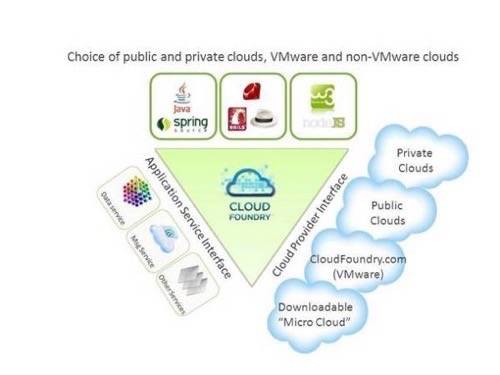VMware is launching an open platform today called Cloud Foundry that provides developers with a choice of framework., app services and the flexibility to run on multiple cloud environments.

Developers may launch the platform as a private, public or hybrid cloud environment. It can run inside the enterprise as virtual infrastructure, on a public cloud such as Amazon Web Services EC2 or as a hybrid cloud solution.
The future of the cloud is one about the predominance of platforms. We’re seeing that reality emerge with this news from VMware. It also points to the increasing importance in providing developers a way to build apps without the usual hassles that come with getting them launched by the IT department.
We have been highlighting this issue in the past few weeks in posts about companies such as SaaSGrid, which offers an internal platform for developers. Developers are increasingly adopting Agile methodologies, which is iterative in its approach. Agile requires updates that would normally take weeks to get approved by IT. Setting up a virtual infrastructure like CloudFoundry provides a secure place where developers can do test and development.
Mozy Gets into the Game
Cloud Foundry will be run by the Mozy team, which is moving from EMC and will be part of VMware. VMware executives explained in an interview yesterday that the Mozy team has the experience of developing a backup service.
Support for Frameworks and Application Services
Cloud Foundry also offers a choice of clouds, frameworks and application services.
According to a draft blog post by VMware CTO Steve Herrod,the platform supports Spring, Grails, Node.js and Ruby on Rails with work already underway for other frameworks. It will be open to multiple services, provided by VMware or other vendors or communities.

Initially VMware will provide basic services such as a relational database, but the choice will broaden quickly. He writes that other initial choices are MySQL, Redis
and MongoDB. RabbitMQ will soon follow.
Cloud Foundry will be available as a public cloud service at CloudFoundry.com and as software that can be run according to the developer’s choice.
Cloud Choice
Cloud Foundry can be used on public or private clouds. It runs on top of
vSphere and vCloud infrastructure but VMware says it can also run on top of other infrastructure clouds. At its launch today, RightScale is showing how Cloud Foundry can run on top of AWS. Its open architecture means that it can run on infrastructure technologies like Eucalyptus or OpenStack.
It also has a software component. Herrod:
We’ve even shrunk the cloud down to sit on a developer’s laptop. With the “Micro Cloud”, we have a version of Cloud Foundry that runs in a single virtual machine.This gives allows developers to build and test their applications on their own
machine, with the confidence that their production environment is symmetrical to
the development environment. The Micro Cloud configuration of Cloud Foundry
will be available later this quarter from CloudFoundry.com.
CloudFoundry.org
CloudFoundry.org is the community open source project for the platform environment The code has been uploaded to GitHub. It is available under the Apache 2 license It will be governed like Spring, which has its roots as an open source project.
Summary
Cloud Foundry plays on the number of acquisitions that VMware has made in the past few years. Spring has been a jewel for VMware but now the other parts are falling into place. RabbitMQ and Gemstone are just two examples. The open play is a smart one. And the flexibility of the platform is key to its success.
Cloud Foundry will without a doubt pose a real challenge to Google App Engine and other platforms such as Heroku and even Windows Azure. But this is a competitive space with new startups such as DotCloud offering a similar flexibility.
Is VMware now becoming an open source company? It has the dominance in the virtualization market. Now may be the time it leverages that strength to provide an open environment that gives it leverage across the entire market.





















